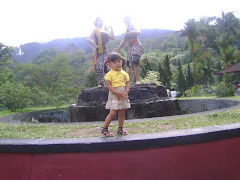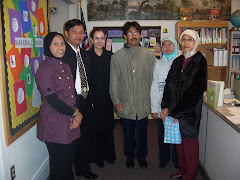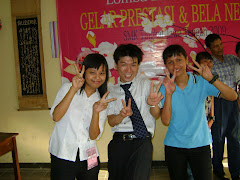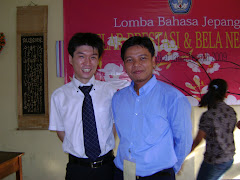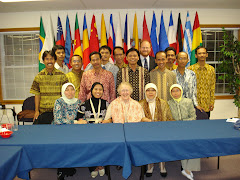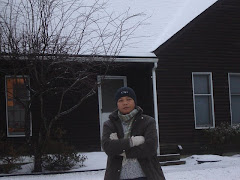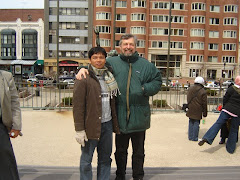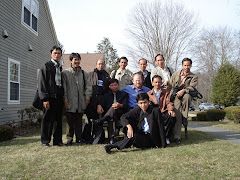Friday, June 19, 2009
Japanese Banknote
¥2000 : Is green in color and has shureimon (守礼門) on one side. Shureimon (守礼門) is the name of one of the gates of Shurijoo (首里城) or Shuri Castle. Shuri Castle is one of the famous castles in Japan. The other side of the banknote has a portrait of Murasaki Shikibu (紫式部). Murasaki Shikibu (紫式部) is the author of Genji Monogatari (源氏物語) or the Tale of Genji.
¥5000 : is purple and contains a portrait of Higuchi Ichiyoo (樋口 一葉), also known as Higuchi Natsuko (樋口 夏子). She is considered one of the most prominent female writers in Japan. Her most famous works are Takekurabe (たけくらべ) and Nigorie (にごりえ). She initially wrote to support her family. Little did she know her work would become famous. The other side contains a painting done by Ogata Koorin (尾形 光琳).
¥10000 : contains a portrait of Fukuzawa Yukichi (福澤 諭吉). Fukuzawa is considered one of the founders of modern Japan. He was a progressive, meaning he supported Japan’s modernization. His lasting contribution to Japanese society came in the form of a newspaper called Jiji Shinpo (時事新報) or Current Events. His newspaper helped the Japanese people gradually embrace change.
Tuesday, June 16, 2009
Japanese Months
February: nigatsu (二月) (にがつ)
March: sangatsu (三月) (さんがつ)
April: shigatsu (四月) (しがつ)
May: gogatsu (五月) (ごがつ)
June: rokugatsu (六月) (ろくがつ)
July: shichigatsu (七月) (しちがつ)
August: hachigatsu (八月) (はちがつ)
September: kugatsu (九月) (くがつ)
October: juugatsu (十月) (じゅうがつ)
November: juuichigatsu (十一月) (じゅういちがつ)
December: juunigatsu (十二月) (じゅうにがつ)
The months are pretty straightforward. All you have to do is place the number of the month with the counter “gatsu”. So for April it would be the word four or “shi” plus gatsu, which means month. The first parentheses contains the kanji and the second parentheses contains the hiragana.
Saturday, June 13, 2009
UJP's tradition in UN
Wednesday, June 10, 2009
Labels of Japanese People
Issei (一世) refers to people who were born in Japan, but have immigrated to another country. This term is especially used to refer to people in the U.S and Brazil. It’s also used to decribe the immigrants who came to the U.S. in the late 1800s and early 1900s. The issei (一世) in Brazil were mostly coffee plante laborers. Most of the laborers wanted to earn money and go right back to Japan after saving some money. For most people, this never happened. Low wages prevented people from saving enough money to even buy a ticket back home. The issei (一世) in the U.S. were sugar plant workers in Hawaii. Many had no permanent plans to stay in Hawaii, but ended up but having families and living in the U.S.; never to return to Japan.
The Nissei (二世) is a term used to describe a generation of people who were born to at least one issei (一世) parent and were born in a country other than Japan. The Nissei (二世) frequently suffer from identity crises. It’s usually refers to people who were born after WWI. When they were interned in U.S. and Canadian camps during WWII, many of the nissei (二世) were torn between their Japanese roots and their new found identity as Americans. A lot of the nissei (二世) knew how to speak Japanese and were taught by their issei (一世) parents to uphold Japanese values. However, the nissei (二世) were also taught English and American values in public schools. Many of them were torn as to where they should place their loyalty, especially after they were interned.
The Sansei (三世) is used to describe the generation of people who are born to at least one nissei (二世) parent. In many cases, the sansei (三世) were encouraged by their parents to obtain higher education. This also means that many of the sansei (三世) spoke fluent English and almost little or no Japanese. Unlike the issei (一世), the sansei (三世) typically view themselves as Americans, or Canadians with Japanese ancestry. Some have married outside of the Japanese community and have adopted Christianity as their religion. The sansei (三世) were the most vocal activists in lobbying for the U.S. government to apologize for the internment of Japanese citizens.
Nikkeijin (日系人) is a general term used to describe Japanese emigrants and their descendants. The nikkeijin (日系人) refers to the issei (一世), nissei (二世) and sansei (三世). In many cases, the Japanese government does not grant citizenships to people who are yonsei (四世) and up. If you can prove that you are a sansei (三世) or below, you may apply for citizenship. A similar term is dekasegi (出稼ぎ). Dekasegi (出稼ぎ) refers especially to Japanese Brazilians who have immigrated to Japan to find better jobs. There is considered discrimination against the dekasegi (出稼ぎ). They are not viewed as “Japanese” and are frequently considered as foreigners.
Sunday, June 7, 2009
Sentoo
A sentoo (銭湯) is a public bathhouse. Even though people have bathtubs at home, a sentoo (銭湯) is a bit different from your ordinary bathtub.
A sentoo (銭湯) will have separate sections for each gender. Male children up to ten years of age can go with their mothers. Other than that, the gender division is strictly enforced. That means no peeking! If you’re caught peeking in the opposite sex’s changing room, you’re definitely going to take a trip to the police station, so mind your sentoo manners! The men’s area will have a bluish door with the word otoko (男) on it. The women’s side is red with the word for onna (女) on it. Otoko = man. Onna = woman.
Every sentoo (銭湯) has a locker room where you store your clothes and other belongings. Before you enter the locker room you have to pay an entrance fee. Each sentoo (銭湯) has their own rates. Some charge for the number of hours you plan to stay, while others charge a flat fee no matter how long or short you stay. Once you’ve paid, you’ll be given a key with your locker number on it. In some places, you can store your belongings in any random lockers, except for the ones that are reserved for regular customers.
You are not permitted to wear any clothing once you enter the public bathing area. The only thing you can bring is a small bucket with soap, shampoo, back scrubber, small towel and maybe some sandals. They sell these things at the sentoo (銭湯), but they’re on the pricy side. They bathing area also contains small stools that you can sit on. These stools have been used, so I personally place a towel on the stool, just in case.
The floor of the bathing area is covered with tiles, which can cause your barefoot to get very hot. The bathhouse that I go to regularly, allows people to bring clog-like sandals, so I bring sandals. The sandals allow me to walk around with ease without stinging my feet. However, check with the person at the front desk to make sure you can do this. Not all places allow footwear in the bathing area.
The waters of the sentoo (銭湯) are steaming hot. You can cool off in another room with a bathtub full of cold water. The catch is that you have to pay an extra fee. There’s a person watching at the entrance to this room, so you probably won’t be able to sneak past without paying. Besides, you need to show your wristband, which proves that you’ve paid the extra fee. One way to cool down without having to pay such a big fee is to buy cold drinks at the vending machines.
So why go to a sentoo when you have a bathtub at home? It’s just relaxing. The water never gets cold and you can sit in the water for hours just resting. Too bad I don’t own a sentoo. If I did, I’d go there practically every day.
Friday, June 5, 2009
Answer to Kanji Practice
1) Meaning: space, interval. Kun: ま. On: カン. 間
2) Meaning: three. Kun: み. On: サン. 三
3) Meaning: six. Kun: む On: ロク. 六
4) Meaning: eye. Kun: め On: ガン. 眼
5) Meaning: tree, wood. On: モク Kun: き. 木
6) Meaning: next, come. On: ライ Kun: くろ. 来
7) Meaning: power, strength. On: リイ Kun: ちから. 力
![]() Meaning: weak. On: ルイ Kun: よわい. 羸
Meaning: weak. On: ルイ Kun: よわい. 羸
9) Meaning: cool, cold. On: レイ Kun: つめたい. 冷
10) Meaning: old age, elderly. On: ロウ Kun: ふける. 老
Wednesday, June 3, 2009
Hasil Lomba
Setelah melalui tahapan lomba pada hari Minggu 31 Mei - 1 Juni 2009 akhirnya menetapkan juara - juara sebagai berikut :
- Juara I : Kontingen Kota Semarang
- Juara II : Kontingen Kota Magelang
- Juara III: Kontingen Kab. Purbalingga
Dengan demikian Kontingen Kota Semarang berhak menjadi wakil Jawa Tengah di GPBN Tingkat Nasional .
Adapun rekap penilaian adalah sebagai berikut :
| NO | KOTA / KAB | NAMA PESERTA | NILAI | RANGKING | ||||
| SHODOU | ROLE PLAY | READING | LCC | TOTAL NILAI | ||||
1 | Kota Semarang | Yunitasari | 392,5 | 454,33 | 265,66 | 400 | 1512,5 | 1 |
| Novi Wulandari | ||||||||
| 2 | Kota Magelang | Anarti | 332,67 | 469,33 | 285 | 400 | 1487 | 2 |
| Novarinda Anggi P | ||||||||
| 3 | Kab. Purwokerto | Khaulah Syahdiah | 355,67 | 431,33 | 272,83 | 200 | 1259,83 | 5 |
| Annisa Nur D | ||||||||
| 4 | Kab. Boyolali | Winarno | 306,167 | 376,67 | 236,167 | 200 | 1119 | 8 |
| Ani Mustikawati | ||||||||
| 5 | Kab. Rembang | Siti Kholifah | 289 | 411,67 | 175,83 | 100 | 976,5 | 11 |
| M. Rudi Ainun Najib | ||||||||
| 6 | Kab. Purbalingga | Nur Sulistiowati | 354,5 | 465 | 286,83 | 300 | 1406,33 | 3 |
| Wiwit Adi Saputri | ||||||||
| 7 | Kab. Temanggung | Erlina Puspita Sari | 280,5 | 246,67 | 247 | 400 | 1174,167 | 7 |
| Ristanti | ||||||||
| 8 | Kab. Semarang | Tuti Winarni | 328,167 | 418,333 | 261,5 | 300 | 1308 | 4 |
| Rifatul Hidayah | ||||||||
| 9 | Kab. Cilacap | Weni Nur Andriani | 252,67 | 421,67 | 262,83 | 300 | 1237,167 | 6 |
| Eva April Liliyana | ||||||||
| 10 | Kab. Kendal | Evi Nurlia | 291,33 | 400,67 | 202 | 200 | 1094 | 10 |
| Diyah Ayu Safitri | ||||||||
| 11 | Kab. Purworejo | Lina Anggraeny | 215,33 | 399,33 | 176,67 | 100 | 891,33 | 12 |
| Yulyo Wahyu PT | ||||||||
| 12 | Kota Salatiga | Asep D | 285,167 | 469,333 | 252,83 | 100 | 1107,33 | 9 |
| Purnama | ||||||||
Untuk rekap per mata lomba akan diupload secepat mungkin
Penyelengara Ketua Juri
Idhi Tri Atmojo Iwata Toshikazu
Role-Play Bahasa Jepang
Tuesday, June 2, 2009
Kanji Practice
Here are the answers to the hiragana section: 1) ねこ (cat) 2) なに (what) 3) たこ (octopus) 4) はい (hai) 5) ふうふ (married couple) 6) なか (middle, center) 7) のう (brain) 8) はこ (box) 9) はは (mother) 10) はな(flower)
Here are the answers to the katakana section: 1) テスト (test) 2) ナウ (now) 3) ナイト (night) 4) ナイス (nice) 5) ヌード (nude) 6) ノウ (know) 7) タイ (tie) 8) タフ (tough) 9) ハイ (high) 10) ツー (two)
Today I’m going to give out some kanji exercises. I’ll provide the meaning, the kun reading, which is the native Japanese reading and the on reading, which is the pronunciation borrowed from the Chinese. The on will be in katakana. The kun will be in hiragana. All you have to do is provide the characters in the comment section. All these characters are pretty standard in the Japanese language, so hopefully you won’t have too much difficulty with this exercise.
1) Meaning: space, interval. Kun: ま. On: カン.
2) Meaning: three. Kun: み. On: サン.
3) Meaning: six. Kun: む On: ロク.
4) Meaning: eye. Kun: め On: ガン.
5) Meaning: tree, wood. On: モク Kun: き
6) Meaning: next, come. On: ライ Kun: くろ.
7) Meaning: power, strength. On: リイ Kun: ちから.
Meaning: weak. On: ルイ Kun: よわい.
9) Meaning: cool, cold. On: レイ Kun: つめたい.
10) Meaning: old age, elderly. On: ロウ Kun: ふける


